She presented her story on 31 handwritten pages, which my uncle recently shared with me. I am guessing that she wrote this sometime in the early to mid-1990s, as she mentions it had been 50 years since she summered at the Old Farm. I feel fortunate that she left these memories, and I enjoyed preserving her story.
I added the headings. They were not part of the original story.

~
The Old Farm
A Memoir By Mary Ann Manno Vinciguerra
Though I was born and grew up in Newark, New Jersey, I spent all my summers as a little girl in Warren County. Our place was an old farm on a steep, narrow dirt road near Blairstown off Route 94. My father called it Walnut Valley Road, but I have heard it referred to as Mountainside Road. The Yards Creek Plant is now at the top of that road. 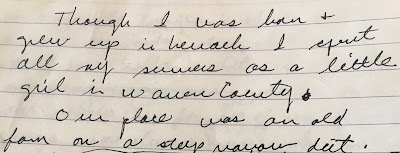 (Transcriber's note: The plant was built in 1965.)
(Transcriber's note: The plant was built in 1965.)
 (Transcriber's note: The plant was built in 1965.)
(Transcriber's note: The plant was built in 1965.)Our curious old house, much altered now, was on one side of the road, but the barns, orchards, and most of the property, which went up into the mountain, was on the other. Fred Belet now makes his home in the big barn and the other big barn, in which we often played, is now his garage. There was an enormous old touring car in there with a big wooden steering wheel. We played cops and robbers in that car. I guess it was the robber’s car for one of my female cousins was always Masie, the robber’s girlfriend. I also remember the big iron anvil in that barn, and the grinding wheel upon which we would play bicycle. Fred Belet has restored the building beautifully inside and out, and I’m so glad a small part of the Old Farm is so lovingly reserved.
The Nicolettis
Across from our house behind the stone wall topped with a wooden fence, were three summer houses in a row. People from New York used them, and they were all related. Old Mr. and Mrs. Nicoletti lived in the first house. The middle house I don’t know much about, and the Perrys lived in the last house. Connie Perry was my brother’s age, and they were very close, excluding my sister and me from their activities. Carmel and Ralph Perry were almost grown, at least in our eyes, and didn’t play with us.
Mrs. Nicoletti kept chickens. Sometimes I was there when she butchered one. She had a funnel shaped device nailed to the corner of the house and after catching a chicken she would put it upside down in the funnel. There it was an easy matter to cut off its head. After she took it out it flopped around on the grass for a while. I don’t remember watching the plucking part.
The Nicolletis had an ice cream churn, and when they made some, we were invited over.
Besides butchering chickens and making ice cream, I remember something else the Nicolletis did. When it was time for the men to drive back to the city on Sunday night, Mrs. Nicoletti would give us all bells, and as the cars drove down the road, we would ring the bells in farewell until the cars were out of sight. This didn’t last long, as the road had a curve soon after our houses, so we children rang furiously to take advantage of that special moment. Since the Nicolettis were from New York, I don’t know if this farewell was a Warren County tradition, but it is a part of my memories of summers spent there.
The Nicoletti’s grandson spent some summers with them, and our cousin Frankie liked to play with him. Once we were up in our apple tree, hidden by the leaves. Mrs. Nicoletti, in her long skirt and apron, came to the orchard calling for her grandson to come home. Not wanting to leave, Frankie waited until Mrs. Nicoletti was under the tree and shook apples down onto her head.
Keeping House
Busy playing all day and being outdoors as much as possible, I gave little thought to what it took to keep the house at the Old Farm running. The scent of kerosene stirs something in my memory, but I was too young to really remember when the kerosene lamps gave our only source of light. We had an icebox, too, and I was always surprised that the delivery men knew where to find us up that long, dusty road.
I don’t remember the kerosene lamps, but I do remember the outhouses (We had two). After out last trip of the day, before bed, we rushed back to the house not knowing what scary things were lurking in the still countryside that surrounded us.
People still talk about the blueberry pies my mother turned out from the ovens and coal stove. We picked blueberries in the fields across the road, always taking with us long sticks for the snakes. We could fill pails of berries in no time, and I don’t think my mother ever made fewer than six pies at once.
Needing wood for the stove, we had a woodshed, a small building with a shingled roof. I remember the moist, sappy smell of the place. When the wood box needed to be filled, Frankie would have us hold out our arms, and he would load them with logs as high as possible. There we would march proudly into the house with our loads.
Walking to Get Milk
One of the necessary but special things we did a few times a week was our walk down the hill to get the milk. We set out after dinner while there was still plenty of light. Past our barns, we went around the bend. There we passed Stony Brook and Stony Lonesome on either side of the road. They were summer places and couldn’t be seen from the road. We liked the names. One of the “Stonys” burned down during the winter, and the following summer when we walked to the place to see the ruins, I found a burned, twisted spoon in the ashes.
After Stony Brook and Stony Lonesome the road became even steeper, and we went down Price’s Hill. Mrs. Price was also a summer person. She always had pretty flowers around the outhouse. We thought the outhouse was special because it was supposed to resemble a phone booth with the number 4U2PP. When we were old enough to understand, we thought that was hilarious. Mrs. Price’s house was another that burned to the ground one year, and I guess the outhouse went with it too.
Across from Mrs. Price in a very little house lived old Fred. Sometimes on the walls of his big barn Fred would have nailed the head of a snake. He told us you had to do that after you kill a snake because they really didn’t die until (indecipherable). Whenever we passed Fred’s, we looked on the barn to see if anything was hanging there.
I don’t know why we though that Fred, his little house, and his big barn all “belonged” to Mrs. Price. It may be that it was Fred’s own little patch of land.
Then our walk took us around the big bend (The “new” road to Yards Creek doesn’t go here.) and over the arched stone bridge. We always stop to look over both sides of the bridge down to the brook and sometimes dropped a few stones in it.
Continuing down to the right we would see Jams & Jellies, which was on (indecipherable) Road. This was the only name we knew for the ladies who lived there, for that’s what their sign said. Our cousin Frankie was very enterprising and a few times he picked berries in Jams & Jellies own fields, and then walked to their door and sold those to them.
After Jams & Jellies, we would pass the stone pillars with lions’ heads set in them that marked the long driveway to Villa Sansone. On the right was the little cabin
of the man whose son was killed when he fell off a roof. This was a good time for my mother to remind us what happened to children who didn’t mind their parents.
of the man whose son was killed when he fell off a roof. This was a good time for my mother to remind us what happened to children who didn’t mind their parents.
Then, still going lower, the “farmers’” houses were next, one on each side of the road. We called them farmers but the biggest crop they grew was children. There were always several of them up on the porches and more about the property. I admired their ability to walk anywhere barefoot, but I was glad I could wear shorts or slacks or a sundress in the summer. Those little and big girls were always in the same type of dress, no matter what the weather.
On we continued, and the road began to level out. On the left was a house with a low porch across the front and often an old couple (I guess all adults seemed old to us.) were sitting on the porch. The man had a ear trumpet to aid his hearing. Once when my father was driving by his house, he ran over one of their chickens. They negotiated a settlement, and I guess that ear trumpet was a great aid to the old man at that time.
Then finally we were at the Channing’s. The house was neat, the barn was neat, and Mrs. Channing was neat. We never watched the milking. Maybe the barn was off limits to us as we often watched the milking at the next summer place we had. But I do remember visiting the pigs. Their pen was the only untidy place on that farm.
After the milk was in, I sometimes watched Mrs. Channing strain it into a cloth. I think this was done in the house either in the neat kitchen or possibly the neat tearoom.
Before we left the nice farm, we usually visited the outhouse. The interior was papered in pretty magazine covers and it was a pleasure to sit there and see kittens, babies, flowers, and other illustrations. It was nicer than Mrs. Price’s outhouse, which was mostly for show anyway.
Then we took the still warm milk and began the long walk back. By this time dusk was rapidly falling. Summer nights must have been cooler there, for I remember we wore sweaters and whenever bats swooped too low, we would grab the backs of our sweaters and cover our heads. We thought that bats could drop something sticky onto our heads and it would have to be cut out along with our hair. Maybe Fred told us that.
So, clutching milk bottles and protecting our heads, we trudged up the hill until at last we approached our bend and could see a part of our big red barn. Sometimes at this point we would sing, “Just around the corner there’s a rainbow in the sky. So let’s have another cup of coffee, and let’s have another piece of pie.” (This bend in the road is where Mrs. Price lived and has been by-passed by the new road.)
The only time we would go further down the road would be on a Saturday morning when we were expecting my father. If Frankie were staying with us, sometimes he would take us down to Route 94 to wait for him. When we finally reached the highway, we would wait by the concrete bridge. There was a date inscribed on it. 1923? 1929? Frankie would sometimes lift us up, so we had a seat as we waited. I think that bridge is still there.
My father always had a big grin on his face when he saw his nephew and children waiting for him. Into the big Buick we clambered. Even with a week’s supply of food and other things there was more than enough room for all of us in that old car. The “trunk” was actually a trunk attached to the back and was big enough to hold our many necessities. (When the car was sold my father kept the trunk and my brother packed it and shipped it up to Maine when he started college. He said he was the only Freshman whose trunk said, “Body by Fischer.”)
Back up the hill we traveled, past the lovely stone house on the corner, past the next old house, which had a charming old-fashioned garden, past the little schoolhouse, and then to Channing’s. Up, up, up until we came to the (indecipherable). As we crossed over the brook, we had to slow down for the big bend in the road. Would the reduced speed make it impossible to make it up Price’s hill on the first try? Would my father have to back up and make a fresh attack on the hill? We would all lean forward in the back seat to “help” the car along.
Another exciting happening would be meeting with an infrequent car coming down the road. Then both drivers would have to steer to the right side, right into the dusty bushes. With smiles and waves our car would proceed while the other waited. Probably the car going up that steep hill had the right of passage!
It wasn’t often that cars drove by our house and whenever we heard one, even if we were at the dinner table, we all jumped up to see who was passing by. We weren’t reprimanded for this as the grownups did the same thing.
Besides the Saturday rides, we usually didn’t ride in a car all summer. I remember once going to Blairstown with someone staying with us. I was allowed to buy something in the 10-cent store, probably a coloring book or paper dolls. Another time I remember a short ride in a rumble seat. But otherwise, we walked everywhere we had to go.
 The people across the way would have their field mowed once a summer. If there were “older” young people visiting them, they would organize a hayride. The driver was very obliging. He probably was one of the farmers from down the road. These hayrides were the only other mode of transportation and much less frequent than even a car ride.
The people across the way would have their field mowed once a summer. If there were “older” young people visiting them, they would organize a hayride. The driver was very obliging. He probably was one of the farmers from down the road. These hayrides were the only other mode of transportation and much less frequent than even a car ride.Though we went down the road a lot, we didn’t travel in the other direction as much.
Once we visited Ray Bender when he broke his leg. He lived past the Prices, well off the road. His house was a tranquil, rustic, unpainted cabin with a porch high across the front. Ray was in a wheelchair on the porch.
His mother told us that one day the bailing ball rolled under a piece of furniture and when she stopped to retrieve it, she found a copperhead coiled there. Ray sometimes wore rattlesnake rattles. We would have loved to take one back to school, but Ray charged 50 cents and my mother wouldn’t pay that much.
Ray’s father walked by our house every morning on his was to work. He carried a tin lunch pail. He had to go all the way to the highway, and I think when he got there, he had to hitch a ride to where he worked. In the evening he had the long walk up again. I wonder what he did in the winter.
Genuine Swimming Holes
Past Ray’s, past houses that I think said “Bauer” and “Bender,” we would sometimes swim in Vanilla’s pool. Vanilla’s also had a well out front, and we always stopped to let down the pail and have a good drink. There is a little (indecipherable) garden there now where the pool used to be. The house is at the end of the road, where the Yards Creek entrance is.
We had a few genuine swimming holes. When we were very little, we swam in the brook across from Mrs. Price’s. Fred would get his sickle and make a path for us down to the water when we arrived for our first swim of the summer. There was a small, quiet pool where we did our bathing, and the water that ran into and out of the swimming area rushed along and babbled like a brook should. There were big smooth slabs of rock we could spread out on when we got out. The water must have been frigid, and the rocks warmed by the sun must have felt wonderful. I do remember how we loved to go there and the fun we had in the water.
Further down from the brook we would turn off the road and go down the road past Jams & Jellies. On that road was a dam. You couldn’t see the dam from the road but had to walk through a big field. On a hot summer’s day, the grasses felt stiff and crunchy, and after a while it was quite a contrast to find ourselves in deep shade under huge pine trees. When I think of going to the dam, the scent of dry grasses and pine needles always comes to mind. I think there was a tiny house of sorts where we sometimes undressed.
The big kids swam from the concrete dam itself. Sometimes Frankie would climb up a tree on the other side and swing from a tire and drop into the water. We swam at the other end where the water was shallow.
The other swimming hole was closer to our house, down Jake’s Lane. This was past our barns at the bend in the road. The charming stone cottage at the corner is still there. I have heard my father tell the story of how Jake Eckstein appeared at our house one day greatly agitated. He had bought land adjacent to ours and had started to build himself a house when he discovered we was building on our land. My father soon reassured him that it was okay, and they came on a neighborly agreement. I think the affair of the run-over chicken and the man with the ear trumpet was harder to settle.
In contrast to the way to the dam, Jake’s Lane was bordered with trees on both sides, and when I think about walking there, I remember the damp, earthy smell of the woods. Once as we approached the lake a great white heron rose up and flew away startling us all.
Sometimes we would take a bar of soap with us to these places, even after we had a bathroom. It was fun to bathe outdoors and play with the suds.
Whenever we returned from swimming, especially if we had been to the brook or the dam, we were very thirsty. We would run to our pump house and Frankie would pump up the coldest, most delicious water in the word. We kept jelly glasses there for drinking, and everyone had a turn. At these times it was good to be the youngest and go first.
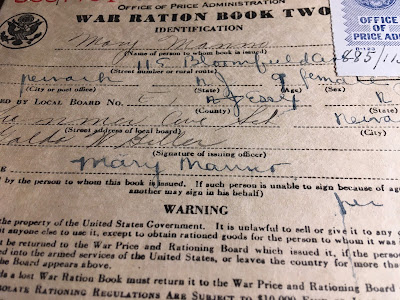 |
| "If you don't need it, don't buy it." |
Our last summer at the Old Farm was in 1943. With the war and gas rationing, my father was worried about making the trip each week. As he was self-employed, he had a very low allotment. For some reason and probably because the children were getting older and craved more action in the summer, the New York people from across the way didn’t go up much.
My mother told me just a few years before she passed away that she never slept well when my father wasn’t there. She even wanted my father to sell the place the first time the three of us got poison ivy!
So, the Old Farm was sold to the Gebhardts, who had a summer camp for children there for a while. Now the farm has been divided, a new road goes behind the house, and only two of the barns are left across the way. They are beautifully kept by Fred Belet. The apple trees are gone, but the mountain beyond will always be there.
Back to the City and on to the Next Old Farm
During the months we were in the city, we would hear infrequent news of what was happening back in the country. We read in the Newark Evening News that the last covered bridge over the Delaware River was washed away in a storm, of a bear caught by hunters on our mountain, of a wreck of a small airplane there, too.
When we heard of these happenings, we felt set-apart and more privileged than our friends because of our knowledge of these places. They never walked on a road where there was no traffic. They never had to go for the milk or go down to the brook for a swim or have a hayride. They didn’t even know what poison ivy looked like or what kinds of places to avoid because of snakes. Yes, we were privileged.
We had another summer place to go the next year, an old farm in Morris Country, and we like it, too. My parents eventually retired there. It was their last home.
Whenever I think of childhood summers it is back to the Old Farm I go. Even after 50 years, the sights and sounds and smells of those long, hot summer days are with me, and when they come to mind I relive once again the perfectly wonderful summers of childhood.
~
A bit more about the Old Farm
My mother's younger sister Helen had these recollections after reading the memoir....
I was too young to remember much except the names. Yes, I had to walk to Channings for milk even though was only a few years old. I was also too young to be allowed to go many places without an adult, unlike my brother and sister. I remember being in the barn and in the old car but that is all. I remember going to the brook to swim. One story she forgot was us walking to the brook (I thought it was Jake but maybe it was Fred) who came out when we all screamed because there was a snake in the road. He killed it for us. It was poisonous, but I don't remember what kind. My memory only includes having electricity. Our cousin Frankie took me all over on his bicycle. How my mother let me go with him I do not know as he was a little bit of a trouble maker. But he was wonderful to me and all us kids. I guess I was 3-5 when he took me and I have no idea what he was up to as there wasn't much to do.
Your mother loved the Old Farm. The there was something magical about it. Maybe the isolation. Her writing makes it sound like there were people all over but we could go days and days without seeing anyone outside our house. We always had company as I don't think grandma would have stayed there otherwise. No one had a phone! No one had a car. Not even the neighbors. It was a special time. I wish I remembered more.
Here is a map of the area. You'll notice Walnut Valley Road, the reservoir, and the Yards Creek Generating station, all which are mentioned in the memoir. You'll also notice the green dotted line at the top of the map, which is the Appalachian Trail.
I only went to the Old Farm once to scatter some of my mother's ashes. Here is the house in 2018, obviously much changed since it was last owned by my grandparents in 1943.
One of their barns.
What in earth is an apple knocker? The Old Farm features prominently in this post: https://annvinciguerra.blogspot.com/2015/07/what-on-earth-is-apple-knocker.html
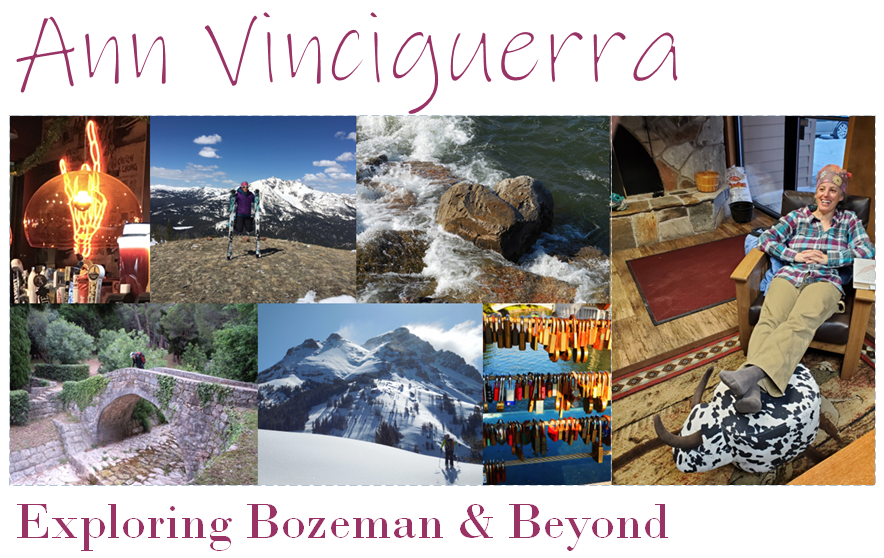

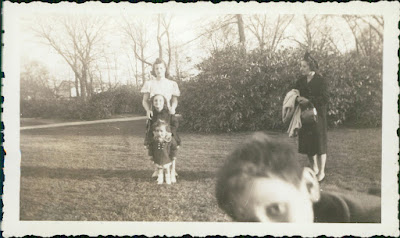
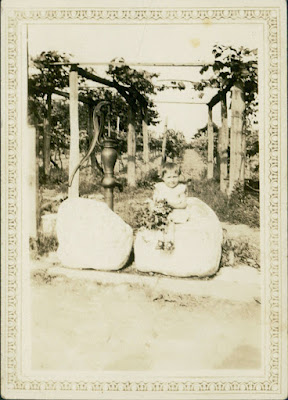





No comments:
Post a Comment